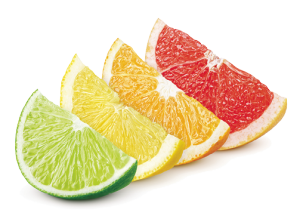From humble beginnings in the forests of Southeast Asia, the citron is the oldest known member of the citrus family. This small evergreen tree, which produces an oblong fruit with a thick, tender rind, found its way to Mesopotamia where it became a highly regarded fruit. It was bitter, so it was not consumed the same as our lovely, juice-filled citrus today. For centuries, the peel of these golden fruits were candied or preserved, or used medicinally as an antidote for poison, an antispasmodic, a sedative and as an antibiotic. Quite prominent in its time, citron was featured on the coinage by the first king of Judea in the second century B.C. while also being described in the Bible. Excavations from ancient Mesopotamia sites have found citron seeds dating as far back as 4000 B.C.
 From this single variety, citrus fruits are now one of the most prolific fruit families on Earth. Multiple varieties, including those we know today such as the sweet orange, lime, lemon and grapefruit, have been cultivated for over a millennia. Here in the U.S. citrus fruits were unknown until the 1500s. Brought here by Spanish explorers, major cultivation in Florida was not established until the early 1800s. Due to freezing temperatures, the Florida citrus industry has suffered over the years. Currently, California, Arizona and Texas have taken up the slack with highly productive orchards. Although we see citrus in our grocery stores year-round, peak season for most citrus runs November through April.
From this single variety, citrus fruits are now one of the most prolific fruit families on Earth. Multiple varieties, including those we know today such as the sweet orange, lime, lemon and grapefruit, have been cultivated for over a millennia. Here in the U.S. citrus fruits were unknown until the 1500s. Brought here by Spanish explorers, major cultivation in Florida was not established until the early 1800s. Due to freezing temperatures, the Florida citrus industry has suffered over the years. Currently, California, Arizona and Texas have taken up the slack with highly productive orchards. Although we see citrus in our grocery stores year-round, peak season for most citrus runs November through April.
Though primarily a warm weather fruit, you can try growing citrus in the Northland. Citrus trees need warm days, approximately 70-75 degrees, and cool nights, 45-55 degrees. This works for our summer months, but move your citrus tree indoors in the winter. Check out Rodale’s Ultimate Encyclopedia of Organic Gardening for a list of varieties that are naturally small and adapt well to both cooler temperatures and life in a container.
Citrus fruits have grown in popularity due to their high levels of vitamin C. An essential nutrient for humans, vitamin C is vital since we do not make it on our own. In fact, humans are one of the few species of animals that do not produce the enzyme responsible for converting glucose into vitamin C within the body. This means we must get it through food. It was noted throughout history that sailors on long voyages succumbed to scurvy, an illness characterized by bleeding gums, skin hemorrhages, severely weakened bones and eventually death. In the late 1700s, it was discovered that lack of vitamin C was the culprit and all European ships carried citrus rations as prevention.
Today, we recognize vitamin C for its tremendous role as an antioxidant. Research shows that vitamin C works as the hub of all antioxidants, actually helping replenish other antioxidants such as vitamin E to help fight free radical damage within the body.
This action as an antioxidant is believed to be behind the reason we reach for vitamin C at the first sign of a cold. Although several studies have shown that Vitamin C does very little to prevent or cure the common cold, it does help support reduction of symptoms and decrease duration.
One orange contains approximately 65mg of vitamin C, which is equivalent to the established recommended daily value. On these cold winter days, reach for a piece of rich, juicy citrus fruit at its peak.
Orange-Honey Glazed Chicken
1 tablespoon olive oil
¼ cup onion, finely chopped
2 cloves garlic, crushed
¼ cup orange juice
¼ cup honey
2 tablespoon soy sauce
2 teaspoon paprika
½ teaspoon ground ginger
1 chicken, approximately 3-1/2 pounds, split in half lengthwise
Add salt & pepper to taste
Preheat oven to 375 degrees. Heat oil in a skillet over medium heat. Add onions and garlic and sauté, stirring often, approximately 5 minutes or until onions soften. Stir in orange juice, honey, paprika, ginger, salt and pepper. Bring to a boil and simmer for 3 minutes until slightly thickened.
Place chicken in a roasting pan, skin side up, and spoon half of the orange mixture over the chicken. Roast for 20 minutes.
Spoon remaining orange mix over the chicken and roast for an additional 20 minutes. Baste until cooked through. Serve in slices with pan juices.
Broiled Grapefruit
Preheat oven to broil or 550 degrees.
Cut grapefruit in half and remove any seeds. Cut around the edges and segments to loosen. Sprinkle half of each grapefruit with brown sugar or drizzle with maple syrup. Broil grapefruit 4-6 inches from heat until juice bubbles and edges of peels turn light brown, approximately 5-10 minutes. Serve hot.




